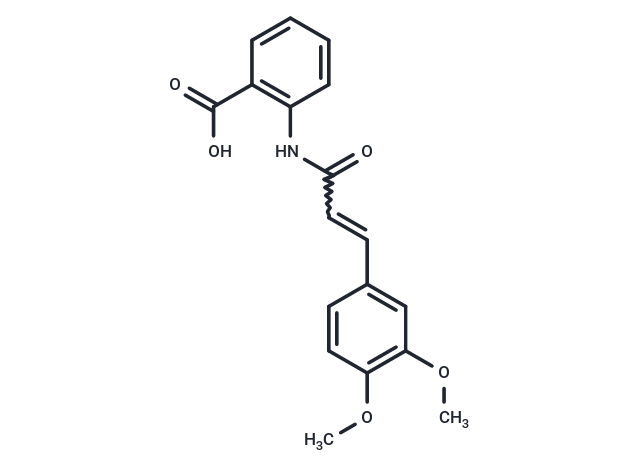Shopping Cart
- Remove All
 Your shopping cart is currently empty
Your shopping cart is currently empty

Tranilast (SB 252218), an antiallergic drug, suppresses lipid mediator and cytokine release from inflammatory cells, therefore utilized in the treatment of allergic disorders.

| Pack Size | Price | Availability | Quantity |
|---|---|---|---|
| 5 mg | $36 | In Stock | |
| 10 mg | $50 | In Stock | |
| 25 mg | $61 | In Stock | |
| 50 mg | $85 | In Stock | |
| 100 mg | $122 | In Stock | |
| 200 mg | $185 | In Stock | |
| 500 mg | $313 | In Stock | |
| 1 mL x 10 mM (in DMSO) | $50 | In Stock |
| Description | Tranilast (SB 252218), an antiallergic drug, suppresses lipid mediator and cytokine release from inflammatory cells, therefore utilized in the treatment of allergic disorders. |
| Targets&IC50 | PGD2:0.1 mM (IC50) |
| In vitro | In diabetic rats' hearts, Tranilast reduces the phosphorylation of Smad2, effectively mitigating cardiac fibrosis. |
| In vivo | In hypertrophic and proliferative scar tissues, Tranilast ([3-300 mM]) inhibits collagen synthesis in fibroblasts by suppressing the Transforming Growth Factor (TGF)-β1, yet it does not inhibit the fibroblasts in normal skin. |
| Kinase Assay | His-tagged human Mps1Cat encoding amino acids 510-857 is generated. For kinase assays, 500 ng is added to buffer (25 mM Tris-HCl, pH 7.4, 100 mM NaCl, 50 μg/mL BSA, 0.1 mM EGTA, 0.1% β-mercaptoethanol, 10 mM MgCl2, and 0.5 μg/mL myelin basic protein), AZ3146, and 100 μM γ-[32P]ATP (2 μCi/assay). Reactions are incubated at 30°C for 20 min, spotted onto P81 paper, washed in 0.5% phosphoric acid, and immersed in acetone. Phosphate incorporation is determined by scintillation counting. For immunoprecipitation kinase assays, HeLa cells are treated with nocodazole for 14 h, mitotic cells isolated, washed in PBS, and lysed for 30 min in 50 mM Tris-HCl, pH 7.4, 100 mM NaCl, 0.5% NP-40, 5 mM EDTA, 5 mM EGTA, 40 mM β-glycerophosphate, 0.2 mM PMSF, 1 mM DTT, 1 mM sodium orthovanadate, 20 mM sodium fluoride, 1 μM okadaic acid, and complete EDTA-free protease inhibitor cocktail. Full-length Mps1 is immunoprecipitated. Purified complexes are washed with lysis buffer containing 100 mM NaCl and assayed as described for the recombinant protein. To quantify 32P incorporation, reactions are stopped with SDS sample buffer and separated by SDS-PAGE followed by phosphorimaging. The plate is analyzed using a phosphorimager using AIDA software. To assess the specificity of AZ3146, a single-point screen is carried using kinase profiling service. 50 kinases are selected and assayed with 1 μM AZ3146[1]. |
| Alias | SB 252218, MK 341 |
| Molecular Weight | 327.33 |
| Formula | C18H17NO5 |
| Cas No. | 53902-12-8 |
| Smiles | N(C(C=CC1=CC(OC)=C(OC)C=C1)=O)C2=C(C(O)=O)C=CC=C2 |
| Relative Density. | 1.299 g/cm3 |
| Storage | keep away from direct sunlight,store under nitrogen | Powder: -20°C for 3 years | In solvent: -80°C for 1 year | Shipping with blue ice. | |||||||||||||||||||||||||||||||||||
| Solubility Information | DMSO: 50 mg/mL (152.75 mM), Sonication is recommended. | |||||||||||||||||||||||||||||||||||
Solution Preparation Table | ||||||||||||||||||||||||||||||||||||
DMSO
| ||||||||||||||||||||||||||||||||||||

Copyright © 2015-2025 TargetMol Chemicals Inc. All Rights Reserved.